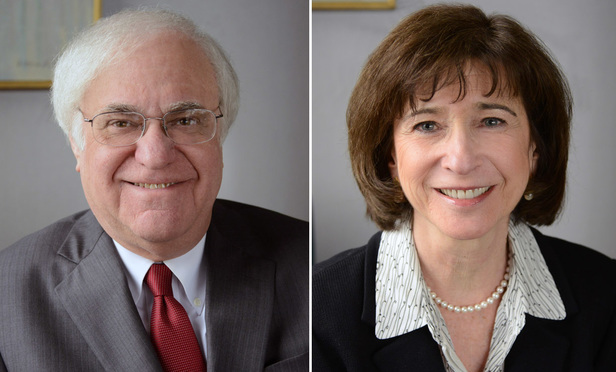Gail S Kelner

March 27, 2017 | New York Law Journal
Re-Evaluating Residential Window Cleaning Under Labor Law §240(1)In their Trial Practice column, Robert S. Kelner and Gail S. Kelner write: Among the enumerated tasks in Labor Law §240(1), the scope of "cleaning" as a covered task has proven to be the most difficult to define. Unlike other activities specified in the statute, cleaning is, by its very nature, a type of maintenance.
By Robert S. Kelner and Gail S. Kelner
23 minute read

January 23, 2017 | New York Law Journal
Applications for Leave to Serve a Late Notice of Claim Under 'Newcomb'Trial Practice columnists Robert S. Kelner and Gail S. Kelner analyze the Court of Appeals' recent decision in 'Newcomb v. Middle Country Central School' and the profound impact it will have on a motion court's discretion to extend the time to serve a notice of claim on a public corporation.
By Robert S. Kelner and Gail S. Kelner
22 minute read

November 21, 2016 | New York Law Journal
Expert Disclosure Under CPLR 3101(d): 'Rivera v. Montefiore Medical Center'In their Trial Practice column, Robert S. Kelner and Gail S. Kelner explore 'Rivera v. Montefiore Medical Center', in which the Court of Appeals addressed the push and pull between an inadequate expert witness disclosure, the timeliness of an objection to such a disclosure, and the proper exercise of discretion by the trial court. An examination of the result in this case highlights the importance of vigilance in the examination of an expert witness disclosure and prompt action in conveying objections to any lack of sufficiency. Rivera makes it clear that the scope of judicial discretion in resolving these issues at trial is very broad.
By Robert S. Kelner and Gail S. Kelner
19 minute read

September 26, 2016 | New York Law Journal
Late Disclosure of Self-Serving MaterialTrial practice columnists Robert S. Kelner and Gail S. Kelner address the manner in which the courts have addressed the untimely disclosure of fact witnesses and party submissions which conflict with existing evidence and are introduced for the first time in opposition to a summary judgment motion. They also discuss a recent change to CPLR 3212(b) which clarifies the consideration by the court of expert affidavits in summary judgment motions.
By Robert S. Kelner and Gail S. Kelner
21 minute read

July 26, 2016 | New York Law Journal
Tort Liability and the 'Self-Driving' CarRobert Kelner and Gail Kelner of Kelner & Kelner forsee that self-driving cars will inevitably be the subject of litigation in New York. In their Trial Practice column, they look at the present automated technology, and then discuss where the law may go with these self-driving cars.
By By Robert S. Kelner and Gail S. Kelner
24 minute read

May 23, 2016 | New York Law Journal
Intersection Collisions Involving Pedestrians in CrosswalksRobert S. Kelner and Gail S. Kelner discuss recent case law, most notably 'Quintavalle v. Perez' from the First Department, that address the proof necessary to impose liability as a matter of law where a driver strikes a pedestrian in a crosswalk who has the right of way in an intersection. The analysis is two-pronged. Plaintiff must show negligence of the operator and plaintiff's freedom from comparative fault.
By Robert S. Kelner and Gail S. Kelner
28 minute read

March 22, 2016 | New York Law Journal
Establishing Liability Under Labor Law §241(6)In their Trial Practice column, Robert S. Kelner and Gail S. Kelner write: Causes of action under Labor Law §240(1) and Labor Law §241(6) are commonly pleaded in construction accident cases. Both statutes impose nondelegable duties on contractors, owners, and their agents, to provide specified protections to workers. However, the two statutes have material differences in their theories of liability and in the proof they require.
By Robert S. Kelner and Gail S. Kelner
24 minute read

January 26, 2016 | New York Law Journal
The Emergency Doctrine in Negligence CasesIn their Trial Practice column, Robert S. Kelner and Gail S. Kelner write: The duty of care is a critical concept in negligence actions. The emergency doctrine recognizes a modified standard where there is a qualified emergency. Key issues include whether there is a qualifying emergency, and whether the actions of a party faced with such an emergency situation were reasonable and prudent under the circumstances.
By Robert S. Kelner and Gail S. Kelner
13 minute read

November 24, 2015 | New York Law Journal
Size Isn't Everything: Trivial Defects Under 'Hutchinson'In their Trial Practice column, Robert S. Kelner and Gail S. Kelner discuss the issues raised where a defendant seeks dismissal of an action where a tripping defect gave rise to injury by alleging that the defect was trivial and not actionable as a matter of law.
By Robert S. Kelner and Gail S. Kelner
13 minute read

November 23, 2015 | New York Law Journal
Size Isn't Everything: Trivial Defects Under 'Hutchinson'In their Trial Practice column, Robert S. Kelner and Gail S. Kelner discuss the issues raised where a defendant seeks dismissal of an action where a tripping defect gave rise to injury by alleging that the defect was trivial and not actionable as a matter of law.
By Robert S. Kelner and Gail S. Kelner
13 minute read
More from ALM
- Legal Speak at General Counsel Conference East 2024: Match Group's Katie Dugan & Herrick's Carol Goodman 1 minute read
- Legal Speak at General Counsel Conference East 2024: Eric Wall, Executive VP, Syllo 1 minute read
- Legal Speak at General Counsel Conference East 2024: Virginia Griffith, Director of Business Development at OutsideGC 1 minute read



